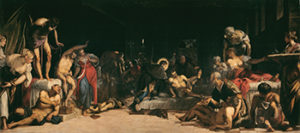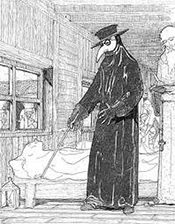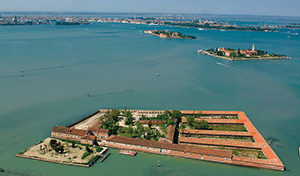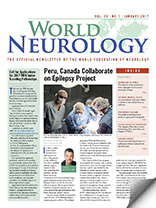By Luigi Bertinato, Venice, Italy
 Navigation and trade have always been the cornerstones of multiple cultural relationships with civilizations of the Mediterranean and the Far East countries. Indeed, the caravans that transported the rarest and most precious wares by sea to the Venetian warehouses arrived from as far as Constantinople and Alessandria.
Navigation and trade have always been the cornerstones of multiple cultural relationships with civilizations of the Mediterranean and the Far East countries. Indeed, the caravans that transported the rarest and most precious wares by sea to the Venetian warehouses arrived from as far as Constantinople and Alessandria.
The patricians of the Serenissima Venetian Republic, as Niccolò Machiavelli pointed out in The Prince, were the only noblemen in the world who thought themselves to be above the humility of practical work. Trading was for these people not only a source of financial gain, but an art form.
To navigate and trade successfully, it was important to gather information on the routes, the coastlines, the islands, and on geographical and climatic details, as well as to understand markets, rates of exchange, money, weights and the differing customs of the people located in other parts of the world. It was important to know how to communicate using conventional sign systems and gestures marked by innate pragmatism reminiscent of those civilizations that converged along the coasts of the huge Mediterranean basin.
From 1348, a dark foreboding began to make its way into the Mediterranean: the plague. Even today, the plague has its natural breeding ground in Kurdistan, in Assyria, and in Central Asia, where it is endemic. It would spread to the convoys that followed the lines of the caravan routes, thereby reaching the ports of the Eastern Mediterranean. The contagion would spread via two main vehicles: a rodent, the rattus-rattus, and the Xenopsilla Cheopis, a flea that lodged itself in the surface hair of the rodent, and then pass on to humans. In the dark, dank corners of the ship’s hold, the rats not only represented a serious threat for the goods and wares, but, more importantly, for the people who would come into contact with them.
Due to its constant contact with the East, Venice would find itself in the frontline. Venice could not give up its trading links with the East on which it based its whole wealth. Therefore, it had to adopt measures for the protection of public health. The result was the invention of the quarantine, or lazzaretto.
The Birth of the Venetian Lazzaretti
From 1348 in this globalized ante litteram world raged the spectre of the plague, which spread along the Mediterranean routes, threatening the survival of peoples in its wake.
While science at the time groped helplessly in the dark for solutions, it was clear to many states that the lethalness, contagiousness and sheer virulence of the plague constituted such an enormous threat that it was necessary to take recourse to collective measures.
On Aug. 28, 1423, during the umpteenth attack of the plague, the Venetian Senate instituted isolation facilities where the plague victims would be housed. In these buildings, there would be medical and nursing personnel at hand, paid by the state. After much deliberation, the choice of location fell upon the Island of Santa Maria di Nazareth, which carried the name of the pre-existing convent, vulgarized thereafter into the term “Nazaretum,” then into “Lazaretum,” and finally into “Lazzaretto.” This name was then adopted by similar types of isolation facilities modeled on the Venetian Lazzaretto, which sprang up elsewhere in the western world.
In 1423, the Senate underlined the importance of information as an indispensable premise for effective and rapid isolation, and the success of prevention. Each and every Venetian — from the captains of large vessels to the sailors on deck, to the citizens themselves — was involved in the fight against the spreading of infection and was encouraged to collect every piece of news, when it surfaced, on cases of the plague in the city and on board the ships, so that affected persons and goods could be isolated immediately.
However, certainly the most original model was that of the quarantine lazzaretto, founded in 1468, which would take in the recovered plague victims for a period of 40 days before they were allowed to return to the city. The lazzaretto, called “Nuovo” or “New” to distinguish it from the pre-existing site named “Vecchio” or “Old,” was used as a quarantine for persons and goods arriving from infected countries. Isolation and purification measures were implemented, requiring constant investment of economic resources as well as the slowing down of the traffic of goods and persons. The priority was to spend on prevention rather than risk economic and demographic ruin as a result of widespread epidemics.
The system of the Venetian lazzaretti was managed, in the context of a wider national and international health care strategy, by the Public Health Care Magistracy of the Venetian Republic (instituted in 1486), thereby creating the model for all Mediterranean ports, which intended to compete with the “Serenissima” Venetian Republic.
Mass Communication on Preventing Measures
It was no easy task to force plague victims and those suspected of carrying the plague virus to be hospitalized in the lazzaretti, which during the 15th Century were tainted by scandal and condemned by their priors for the maltreatment of patients. The health care information campaign and the sensitization of the people to isolation practices reached a peak as a result of the veneration of Saint Rocco who, through his example, inspired people of that time to accept marginalization and quarantining as a means of preventing the spread of disease in populations.
Saint Rocco embodied and, at the same time, exorcised the fears and obsessions which beset the Christian West since 1348, in whom, as a beggar and wayfarer, people saw the image of Christ in need of help. Following the disappearance of the plague in Europe, the fear remained that there could be individuals still around who could spread the infection and cause further deaths. Saint Rocco represented the pilgrim, the traveller who was conscious of the danger of his movements, and the possibility of constituting a vehicle for the spread of infection.
To dissuade people from violating laws on compulsory isolation for plague victims and to discourage all infringements of quarantine norms and of the expurgation of goods and passengers, the Public Health Magistracy adopted exemplary measures such as capital punishment before the seat of the Magistracy at St. Mark’s.
During the plague of 1576, since there were numerous victims and deaths in Venice as a result of coming into contact with the infection raging through the city, the number of citizens who had to be subjected to quarantining procedures in Lazzaretto Novo was high. The small island could not accept all these people, which meant that the sick had to be housed in thousands of ships moored off the island, crammed next to one another, thereby increasing the size of the territory and increasing the ability of the island to take on infected people. At a short distance away from the island, a boat equipped with a gallows served as a warning to those who thought of escaping isolation, and other armed boats patrolled the surrounding waters to tighten the security even further. The proclamation enforces the ban on those coming from infected areas (or suspected areas) when trying to enter the city without undergoing a period of quarantine.
 A plague doctor (see the photo at the right),was a medical physician who treated victims of the plague. They were specifically hired by the Senate of Venice that had many plague victims in times of epidemics.
A plague doctor (see the photo at the right),was a medical physician who treated victims of the plague. They were specifically hired by the Senate of Venice that had many plague victims in times of epidemics.
The plague doctors wore a special costume. The garments were invented by Charles de L’Orme in 1619; they were first used in Paris, but later adapted in Venice with a special mask with a prominent nose. The protective suit consisted of a heavy, waxed fabric overcoat, a mask with glass eye openings and a beak-shaped nose, typically stuffed with herbs, straw, and spices. Plague doctors would also commonly carry a cane to examine and direct patients without the need to make direct contact.
This was thought to protect the doctor from miasma.
The Great Quarantine Warehouses and the Rules of Expurgation
In the 17th century, the health care cordon around the city was optimized, thereby preventing any ship from approaching Venice without being subjected to the necessary controls by the Public Health Care Magistracy. Armed boats patrolled the lagoon to check that nothing was unloaded from the ships arriving from foreign waters. The captains of these ships were obliged to go before the health care office and avoid contact with anyone else, and then to fill out a detailed report about the trip. The Magistrate’s scribe had to collect the details of the captain’s report, and check health certificates and licenses issued by port authorities in the ports visited by the ship in question. These documents had to prove the ship had set sail from ports that were not infected by disease. In case of false declaration, the captain would risk the death penalty. It was quite common that seafarers who had set sail from plague-ridden ports would destroy the documents, thereby asking for licenses to be issued by other ports free from infection. This was a futile trick because the Republic would plant informers and spies all around the Mediterranean area.
In order to gain access to the Venetian ports of the Mediterranean, it was compulsory to exhibit a bill of health. The bill of health or the health license (passport or passpartout) certified the health of individuals and the safety and hygiene levels of goods that were shipped by providing detailed information on ports of call and transit ports used by a particular vessel.
This documentation was issued by the Chancery of the Venetian consulates, which was at the head of the markets in the numerous near eastern ports where ships would berth. At the end of a journey, the licenses were returned to their owners indicating all the ports entered by the vessel.
This is the reason why such documents have been preserved in the consular archives or in the archives of the Venetian ambassador (“bailo”) who resided in Constantinople, and was in charge of the consulates stationed in the Near Eastern Mediterranean.
The Health Care Magistracy of the Serenissima Republic and International Health Care Bulletins
From the date of its establishment in 1486, the health care magistracy had founded preventative policies based on a systematic identification of epidemics in all the countries that traded with Venice, which included the publication and distribution of news concerning the latest developments, through a network of health care offices, diplomatic representatives and similar agencies abroad.
In 1770, a total of 6,990 copies of health decrees rolled off the ducal press, carrying warnings of the dangers posed by the outbreak of plague in specific areas, with relevant dates and bearing the supposed office’s address. All this went to show what a fine system of networks had been adopted in efforts to reach even the most distant localities, and stop the spread via unexpected and lesser known avenues, and avoid the suspension of ties with infected zones.
Infected war vessels as well as those under suspicion of being so were duly reported so that ports could deny them access or send them on to areas equipped with infected lazzaretti. Near-escapes and cases of having resolved the epidemic onboard ships were also made known using the same system of publication and news bulletins.
The Serenissima’s loss of domination over the Adriatic, known for centuries as the “Venetian Gulf,” was having to come to terms in the meantime with yet another business rival, that of Ancona.
Despite the loss of her military and commercial supremacy, the old Republic did continue through its health authorities to control the dissemination of information about epidemics and to spread health warnings via its public announcements, many of which in fact fell on the ears not only of friendly but less than friendly ports.
Poveglia: The Very Last of the Lazzaretti
Over the course of the 17th century, the New Lazzaretto faced a slow and irreversible degradation, made no easier by the surrounding lagoon areas falling prey to swamplands. This forced the Senate into taking into consideration two alternative solutions: either that of undertaking drastic restorations, or building a third lazzaretto on another island. In 1782, the island Poveglia was carefully selected for its proximity to the mouth of the port of Malamocco, with its deep and navigable canals, which had long been in use for the placement of ships in quarantine.
This would have afforded impressive savings on the costs of transporting the goods and passengers to the islands, thus cutting the costs of peate, towing, transfers, and overtime for the health administrators who had the task of keeping their eye on such operations. The project however, had to be set aside, due to a lack of funds, and it was only the emergency created in 1793 by the arrival of an infected Tartan that prompted having to equip the island with quarantine facilities. This necessitated the building of two wooden control centers, one for infected persons and the other for the guards, who in patrolling the surrounding waters with armed boats managed to contain the spread of infection.
After the fall of the Republic, Poveglia continued to be used as an emergency quarantine base for crews afflicted by the plague and, after 1803, yellow fever. The following year, the Austrian government decided that suspected ships coming from Spain were better turned away from the Austrian lazaretti and should instead be sent to the Venetian reception points, which were far better equipped by their isolated position to deal with them. In 1805, plans were being considered for the creation of a large lazzaretto at Poveglia, an idea also taken into consideration by the successive Kingdom of Italy in 1808, but the major obstacle remained in the fact that the island was already used by the military.
In 1814, while the plague continued to break out in many ports of the Levante, Poveglia was finally handed over to the Health authorities, functioning from then on as an isolation center for all Austrian sea ports, and managing the infection to a high degree of success.
Any historical reflection on the role of the Mediterranean Lazzaretti demonstrates that the West had already expressed a common intention regarding health research, many centuries prior to the birth of the European community anticipating the rules adopted today by the World Health Organization, within the so called “International Health Regulation.”
Luigi Bertinato, MD, is public policy adviser in the areas of international public health policies and currently Health Care Manager at the University of Verona,Italy

